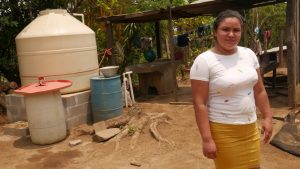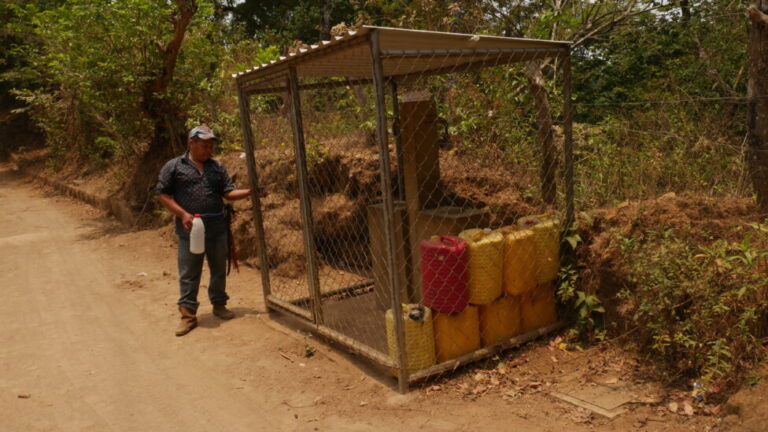
A rainwater harvesting system was installed in the home of Marlene Carballo, in the town of Jocote Dulce in eastern El Salvador, in the Central American Dry Corridor, in November 2022. The system, with pipes and gutters running from the roof to a polyethylene bag, will start operating in May of this year, at the beginning of Central America’s rainy season. CREDIT: Edgardo Ayala/IPS
By Edgardo Ayala
CHINAMECA, El Salvador, May 2 2023 – “This is a very difficult place to live, because of the lack of water,” said Salvadoran farmer Marlene Carballo, as she cooked corn tortillas for lunch for her family, on a scorching day.
Carballo, 23, lives in the Jocote Dulce canton, a remote rural settlement in the municipality of Chinameca, in the eastern Salvadoran department of San Miguel, a region located in what is known as the Central American Dry Corridor.”The husbands go to work in the fields, and as women we stay at home, trying to manage the water supply; only we know if there is enough for bathing or cooking.” — Santa Gumersinda Crespo
Acute water crisis
This municipality is one of the 144 in the country that is located in the Dry Corridor, which covers 35 percent of Central America and is home to more than 10.5 million people and where over 73 percent of the rural population lives in poverty and 7.1 million people suffer from severe food insecurity, according to the United Nations Food and Agriculture Organization (FAO).
Food security is particularly threatened because the rains are not always constant, which creates major difficulties for agriculture.
“My grandfather has a water tank, and when he has enough, he gives us water, but when he doesn’t, we’re in trouble,” said the young woman.
When that happens, they have to buy water, which is not only the case in these remote rural Salvadoran areas, but in the rest of the Central American region where water is scarce, as is almost always the case in the Dry Corridor, which stretches north to south across parts of Guatemala, Honduras, El Salvador, Nicaragua and Costa Rica.
When IPS visited several villages in the Jocote Dulce canton in late April, the acute water shortage was evident, since all homes had one or more plastic tanks to store water and many were empty.

A rainwater harvesting system was installed in the home of Marlene Carballo, in the town of Jocote Dulce in eastern El Salvador, in the Central American Dry Corridor, in November 2022. The system, with pipes and gutters running from the roof to a polyethylene bag, will start operating in May of this year, at the beginning of Central America’s rainy season. CREDIT: Edgardo Ayala/IPS
Women in the forefront of the struggle for water
The persistent water shortage has led rural women in Central America to organize in recent years in community associations to promote projects that help alleviate the scarcity.
In the villages of Jocote Dulce, rainwater harvesting projects, reforestation and the creation of small poultry farms have the support of local and international organizations and financing from European countries.
In some cases, depending on the project and the country, rainwater harvesting is designed only for domestic tasks at home, while in others it includes irrigation of family gardens or providing water for livestock such as cows and chickens.
In other parts of the country and the rest of Central America, institutions such as FAO have developed water collection systems that in some cases have a filtering mechanism, which makes it potable.
In El Salvador, FAO has been behind the installation of 1,373 of these systems.
Carballo said she and her family are looking forward to the start of the May to November rainy season, to see their new rainwater harvesting system work for the first time.
Through gutters and pipes, the rainwater will run from the roof to a huge polyethylene bag in the yard, which serves as a catchment tank.

Gumersinda Crespo (R) and her daughter Marcela stand next to the kitchen of their house in the Jocote Dulce canton in eastern El Salvador, an area with a chronic water crisis because it is located in the Central American Dry Corridor, where the shortage of rainfall makes life complicated. Almost every household in this remote location has various plastic containers and tanks to capture rain. CREDIT: Edgardo Ayala/IPS
“When the bag fills up, we’ll be so happy because we’ll have plenty of water,” she said, as she cooked corn tortillas in her “comal”, a clay or metal cylinder used to cook this staple of the Central American diet.
Women suffer the brunt
The harsh burden of water scarcity falls disproportionately on rural women, as national and international reports have shown.
In this sexist society, women are expected to stay at home, in charge of the domestic chores, which include securing water for the family.
“The husbands go to work in the fields, and as women we stay at home, trying to manage the water supply; only we know if there is enough for bathing or cooking,” Santa Gumersinda Crespo told IPS.
Crespo, 48, was feeding her cow and goat in her backyard when IPS visited her. In the yard there was a black plastic-covered tank where the family collects water during the rainy season.
“Without water we are nothing,” Crespo said. “In the past, we used to go to the water hole. It was really hard, sometimes we left at 7:00 at night and came back at 1:00 in the morning,” she said.

Marta Moreira is one of the community leaders who has worked the hardest to ensure that in Jocote Dulce, a remote rural settlement in eastern El Salvador, programs are helping supply water and strengthen food security. CREDIT: Edgardo Ayala/IPS
In Guatemala, Gloria Díaz also says it is women who bear the brunt of water scarcity in rural families.
“We are the ones who used to go out to look for water and who faced mistreatment and violence when we tried to fill our jugs in the rivers or springs,” Díaz told IPS by telephone from the Sector Plan del Jocote in the Maraxcó Community, in the southeastern Guatemalan municipality and department of Chiquimula.
In that area of the Dry Corridor, water is the most precious asset.
“It’s been difficult, because drinking water is brought to us from 28 kilometers away and we can only fill our containers for two hours a month,” she said.

Almost all of the homes in the villages located around Chinameca, in the Salvadoran department of San Miguel, have several water storage tanks, given the scarcity of water in that area, which forms part of the Central American Dry Corridor. CREDIT: Edgardo Ayala/IPS
Projects that bring relief and hope
Climate forecasts are not at all hopeful for the remainder of 2023.
The El Niño Southern Oscillation (ENSO) climate phenomenon is likely to occur, which would bring droughts and loss of crops, as it has before.
“When the weather is good, we sow and harvest, and when it is not, we plant less, to see how winter (the rainy season) will shape up; we don’t plant everything or we would lose it all,” Salvadoran farmer Marta Moreira, also from Jocote Dulce, told IPS.
Most people in these rural regions depend on subsistence farming, especially corn and beans.
Moreira added that last year her family, made up of herself, her husband and their son, lost most of the corn and bean harvest due to the weather.
In Central America climate change has led to longer than usual periods of drought and to excessive rainfall.

A farmer gets ready to fill a jug at one of the water taps located in the Jocote Dulce canton, in the eastern Salvadoran department of San Miguel, where water is always scarce. The community taps are padlocked, so that only people with permission can use them. CREDIT: Edgardo Ayala/IPS
In October 2022, Tropical Storm Julia destroyed 8,000 hectares of corn and bean crops in El Salvador, causing losses of around 17 million dollars.
Given this history of climatic effects, rural families and groups, led mostly by women, have received the support of national and international organizations to carry out projects to alleviate these impacts.
For example, around 100 families from the Jocote Dulce canton benefited in 2010 from a water project financially supported by Luxembourg, to install a dozen community water taps.
Programs for the construction of catchment tanks have also been carried out there, such as the one that supplies water to Crespo’s family.
In addition to using the water for household chores, the family gives it to their cow, which provides them with milk every day, and Crespo also makes cheese.
The water collected in the pond “lasts us for almost five months, but if we use it more, only about three or four months,” she said, as she brought more fodder to the family cow.
If she has any milk left over, she sells a couple of liters, she said, bringing in income that is hard to come by in this remote area reached by steep dirt tracks that are dusty in summer and muddy in the rainy season.
Other families benefited from home poultry farm and fruit tree planting programs.
Drinking water is provided by the community taps, but the water crisis makes it difficult to supply everyone in this rural settlement.

Yamilet Henríquez, 35, shows the reservoir set up outside her home in eastern El Salvador. Water is increasingly scarce in this area of the ecoregion known as the Central American Dry Corridor, and things could become more complicated if the forecasts are right about the looming arrival of the El Niño climate phenomenon, which will bring droughts and damage to crops. CREDIT: Edgardo Ayala/IPS
Only 80 percent of rural households in El Salvador have access to piped water, according to official figures.
“The water runs for only three days, then for two days the pipes dry up, and that’s how things go, over and over,” said Moreira, who also has a small tank, whose water is not drinkable.
When the rains fail and the reserves run out, families have to buy water from people who bring it in barrels in their pick-up trucks, from Chinameca, about 30 minutes away by car. Each barrel, which costs them about three dollars, contains some 100 liters of water.
The same is true in the Sector Plan del Jocote in Chiquimula, Guatemala, where Díaz lives, and in neighboring communities. “People who can afford it buy it and those who can’t, don’t,” she said.
Díaz added that families in the area are happy with the rainwater harvesting programs, which make it possible for them to irrigate the collectively farmed gardens, and produce vegetables that are important to their diet.
They also sell their produce to nearby schools.
“We grow vegetables and sell them to the school, that has helped us a lot,” she said.
There are 19 water harvesting systems, each with a capacity of 17,000 liters of water, which is enough to irrigate the gardens for two months. They also have a community tank.
These programs, which have been promoted by FAO and other organizations, with the support of the Guatemalan government, have benefited 5,416 families in 80 settlements in two Guatemalan departments.
However, access to potable drinking water remains a serious problem for the more than eight rural settlements in the Sector Plan del Jocote and the 28,714 families that live there.